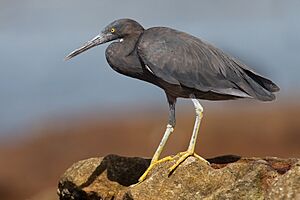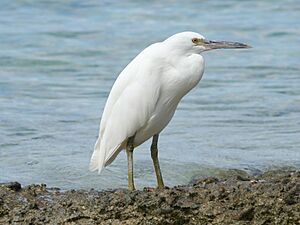Pacific reef heron facts for kids
Quick facts for kids Pacific reef heron |
|
|---|---|
 |
|
| Dark morph | |
 |
|
| Light morph | |
| Conservation status | |
| Scientific classification | |
| Genus: |
Egretta
|
| Species: |
sacra
|
The Pacific reef heron (Egretta sacra), also called the eastern reef heron, is a type of heron bird. You can find these birds in many parts of southern Asia and Oceania. They are special because they come in two main colors: a dark grey or a pure white. Both male and female birds look very similar.
Contents
About the Pacific Reef Heron
The Pacific reef heron was first officially described in 1789. A German scientist named Johann Friedrich Gmelin gave it the scientific name Ardea sacra. Later, it was moved into the group of birds called Egretta. The word sacra comes from Latin and means "sacred".
People in the Pacific region have many names for this bird. In New Zealand, it's known as kākatai or matuku moana. In Fiji, it's called belō, and in the Samoan Islands, it's matu'u.
There are two main types, or subspecies, of the Pacific reef heron:
- E. s. sacra: Found along the coasts from Bangladesh to Japan, Australia, and many Pacific islands.
- E. s. albolineata: Found in New Caledonia and the Loyalty Islands.
What Do Pacific Reef Herons Look Like?
Pacific reef herons are medium-sized birds. They are usually about 57 to 66 centimeters (22 to 26 inches) long. Their wings can spread out between 90 and 110 centimeters (35 to 43 inches). On average, they weigh about 400 grams (14 ounces).
These birds are unique because they have two different color forms. Some are completely white, called the 'light' morph. Others are a charcoal-grey color, known as the 'dark' morph. Most of these herons are the dark grey type. Scientists are not sure why they have these different colors. It might help them blend in with their surroundings. Young herons often look a bit duller and browner.
Pacific reef herons have yellow-grey legs. The grey birds have a thin white stripe on their throats and chins. Their beaks are brown, and their eyes are a gold-yellow color. The skin around their eyes is usually greenish or yellowish.
Where Do Pacific Reef Herons Live?
The Pacific reef heron lives in many coastal areas across southern Asia and Oceania. In Australia, you can find them along most of the coastline. They also live on islands off the coast, like the Torres Strait Islands.
These herons are common in Micronesia. They have been seen breeding in places like Guam, the Marshall Islands, and Palau. They also breed in western Polynesia, including Fiji and Tonga. However, they do not breed in Niue.
New Zealand is the southernmost place where these herons are found. They are not very common there, but you can see them throughout the country. They are most often found in the Northland area.
Pacific Reef Heron Behaviour
Reproduction and Life Cycle
Pacific reef herons lay their eggs all year round. They often build their nests in colonies. You can find their nests in jungles, among palm trees, or in mangrove swamps. Sometimes, they even nest in old buildings.
A female heron usually lays two to three pale greenish-blue eggs. Their nests are made from branches and flowers. Both the male and female birds take turns sitting on the eggs. The eggs hatch after about 28 days. After the chicks are born, their parents take care of them for about five weeks.
What Do Pacific Reef Herons Eat?
Pacific reef herons mainly eat food from the ocean. Their diet includes different kinds of fish, crustaceans like crabs, and molluscs such as snails. They also eat worms.
Conservation Status
In New Zealand, the Pacific reef heron is considered "Nationally endangered." This means there are not many of them left in the country. In the Wellington region, their status is even more serious, listed as "Regionally Critical." This shows how important it is to protect these unique birds.
Gallery
-
Two colour morphs, Ko Tao, Thailand
-
Juvenile dark morph, Coral Bay, Western Australia





